Corporate Finance Assignment: Analysis of Risk and Return Concepts
VerifiedAdded on 2022/08/15
|6
|1065
|12
Homework Assignment
AI Summary
This document provides solutions to a corporate finance assignment, addressing key concepts such as risk and return. The assignment explores how share risk is calculated using standard deviation and dispersion statistics, including the application of the normal distribution. It delves into portfolio risk, explaining how standard deviation of variance in real portfolio returns over time is used to estimate the risk of individual investments, and how portfolio variance is calculated for 2-stock portfolios. The assignment further analyzes the impact of risk-free assets on portfolio risk, demonstrating how the standard deviation simplifies when one asset is risk-free. Finally, it differentiates between systematic and unsystematic risks, explaining how diversification can reduce unsystematic risk while systematic risk affects the entire economy. The document includes references to support the analysis.
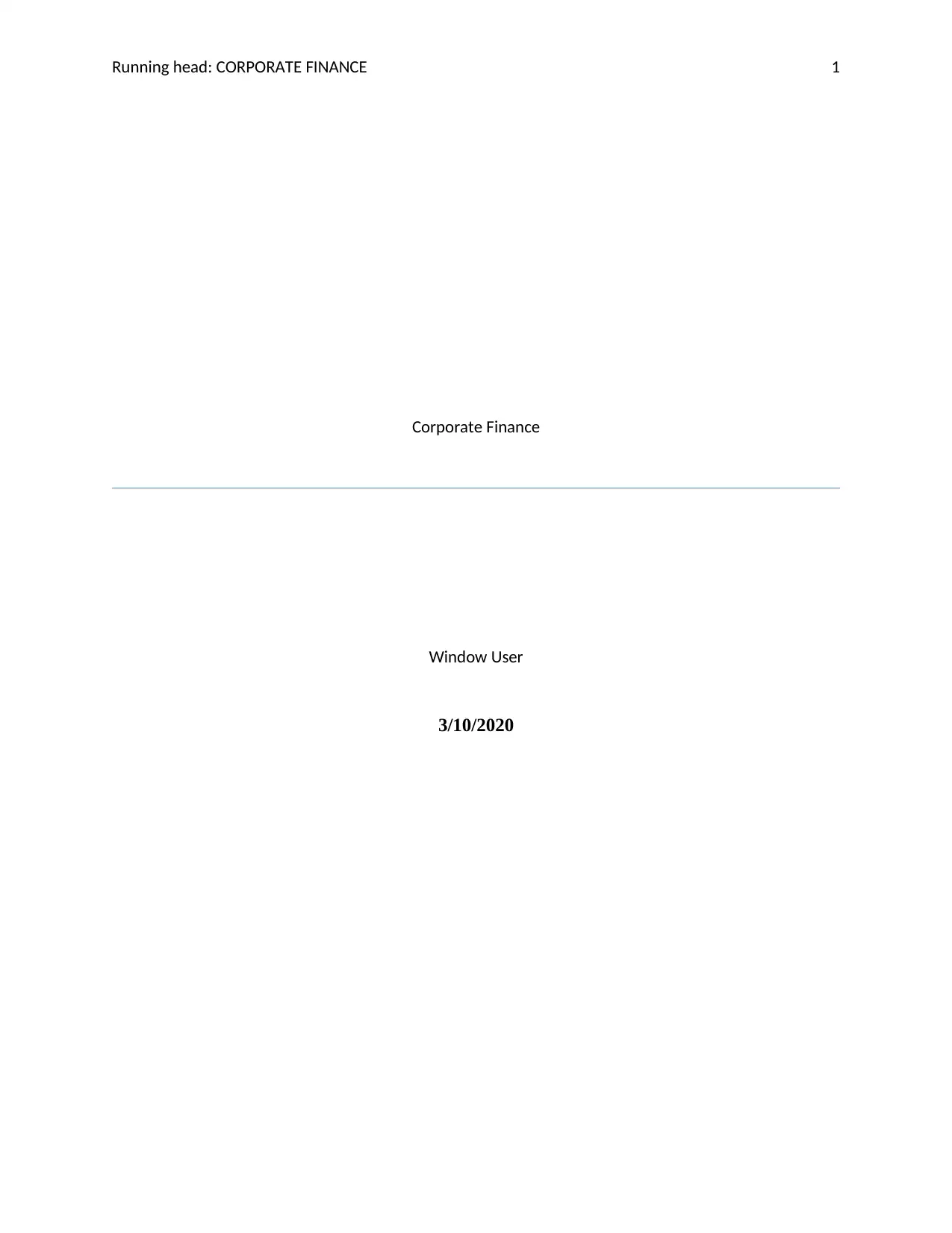
Running head: CORPORATE FINANCE 1
Corporate Finance
Window User
3/10/2020
Corporate Finance
Window User
3/10/2020
Paraphrase This Document
Need a fresh take? Get an instant paraphrase of this document with our AI Paraphraser
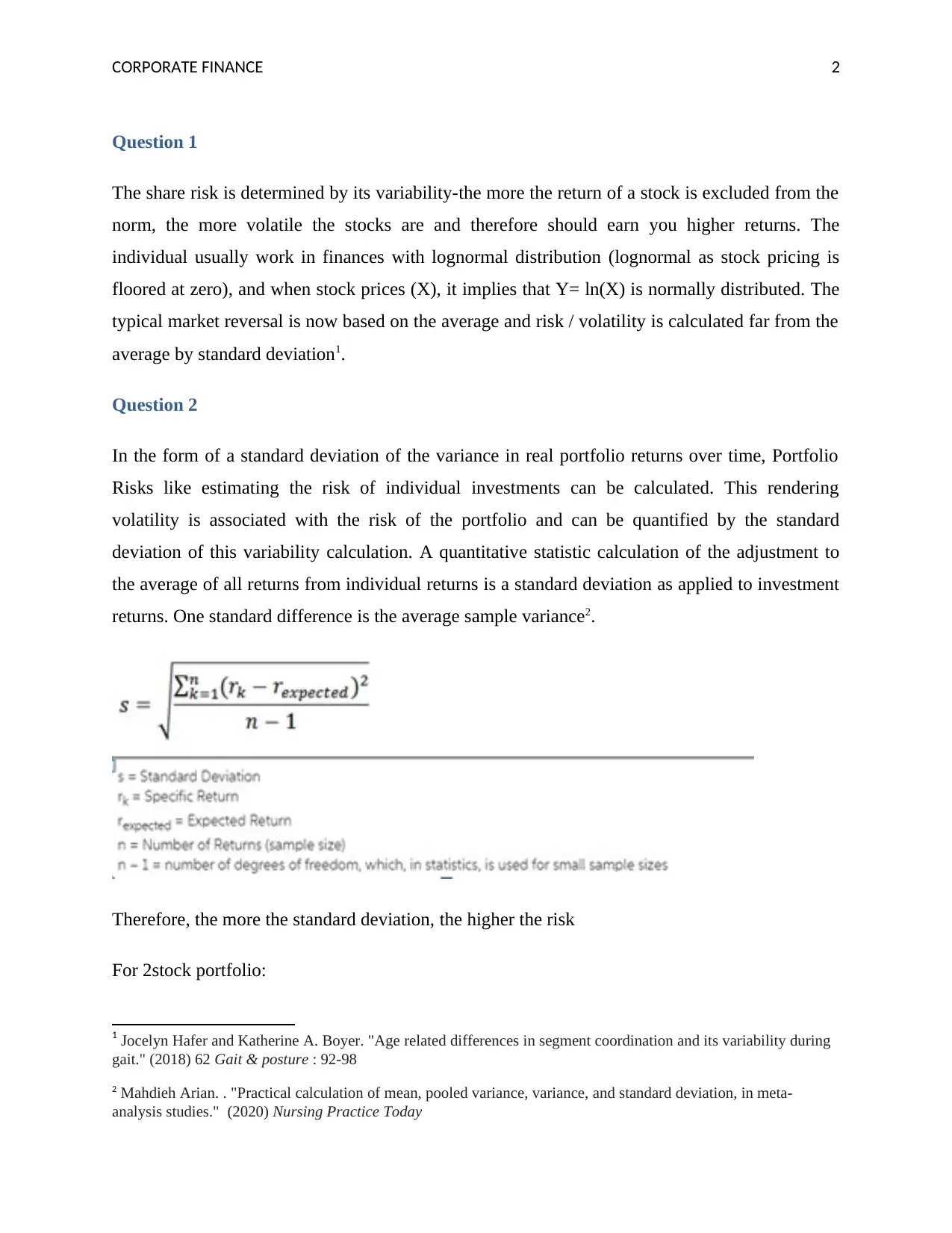
CORPORATE FINANCE 2
Question 1
The share risk is determined by its variability-the more the return of a stock is excluded from the
norm, the more volatile the stocks are and therefore should earn you higher returns. The
individual usually work in finances with lognormal distribution (lognormal as stock pricing is
floored at zero), and when stock prices (X), it implies that Y= ln(X) is normally distributed. The
typical market reversal is now based on the average and risk / volatility is calculated far from the
average by standard deviation1.
Question 2
In the form of a standard deviation of the variance in real portfolio returns over time, Portfolio
Risks like estimating the risk of individual investments can be calculated. This rendering
volatility is associated with the risk of the portfolio and can be quantified by the standard
deviation of this variability calculation. A quantitative statistic calculation of the adjustment to
the average of all returns from individual returns is a standard deviation as applied to investment
returns. One standard difference is the average sample variance2.
Therefore, the more the standard deviation, the higher the risk
For 2stock portfolio:
1 Jocelyn Hafer and Katherine A. Boyer. "Age related differences in segment coordination and its variability during
gait." (2018) 62 Gait & posture : 92-98
2 Mahdieh Arian. . "Practical calculation of mean, pooled variance, variance, and standard deviation, in meta-
analysis studies." (2020) Nursing Practice Today
Question 1
The share risk is determined by its variability-the more the return of a stock is excluded from the
norm, the more volatile the stocks are and therefore should earn you higher returns. The
individual usually work in finances with lognormal distribution (lognormal as stock pricing is
floored at zero), and when stock prices (X), it implies that Y= ln(X) is normally distributed. The
typical market reversal is now based on the average and risk / volatility is calculated far from the
average by standard deviation1.
Question 2
In the form of a standard deviation of the variance in real portfolio returns over time, Portfolio
Risks like estimating the risk of individual investments can be calculated. This rendering
volatility is associated with the risk of the portfolio and can be quantified by the standard
deviation of this variability calculation. A quantitative statistic calculation of the adjustment to
the average of all returns from individual returns is a standard deviation as applied to investment
returns. One standard difference is the average sample variance2.
Therefore, the more the standard deviation, the higher the risk
For 2stock portfolio:
1 Jocelyn Hafer and Katherine A. Boyer. "Age related differences in segment coordination and its variability during
gait." (2018) 62 Gait & posture : 92-98
2 Mahdieh Arian. . "Practical calculation of mean, pooled variance, variance, and standard deviation, in meta-
analysis studies." (2020) Nursing Practice Today
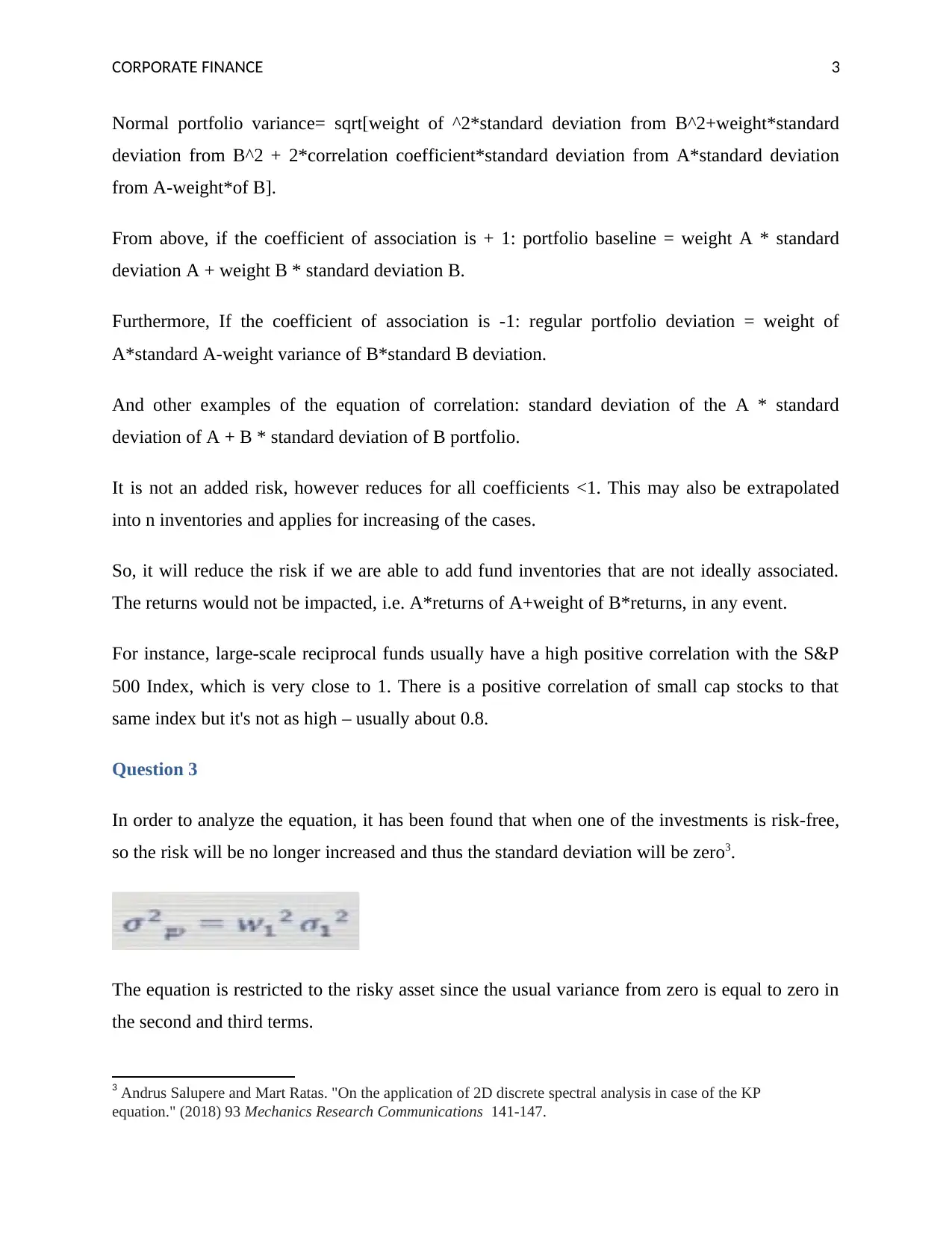
CORPORATE FINANCE 3
Normal portfolio variance= sqrt[weight of ^2*standard deviation from B^2+weight*standard
deviation from B^2 + 2*correlation coefficient*standard deviation from A*standard deviation
from A-weight*of B].
From above, if the coefficient of association is + 1: portfolio baseline = weight A * standard
deviation A + weight B * standard deviation B.
Furthermore, If the coefficient of association is -1: regular portfolio deviation = weight of
A*standard A-weight variance of B*standard B deviation.
And other examples of the equation of correlation: standard deviation of the A * standard
deviation of A + B * standard deviation of B portfolio.
It is not an added risk, however reduces for all coefficients <1. This may also be extrapolated
into n inventories and applies for increasing of the cases.
So, it will reduce the risk if we are able to add fund inventories that are not ideally associated.
The returns would not be impacted, i.e. A*returns of A+weight of B*returns, in any event.
For instance, large-scale reciprocal funds usually have a high positive correlation with the S&P
500 Index, which is very close to 1. There is a positive correlation of small cap stocks to that
same index but it's not as high – usually about 0.8.
Question 3
In order to analyze the equation, it has been found that when one of the investments is risk-free,
so the risk will be no longer increased and thus the standard deviation will be zero3.
The equation is restricted to the risky asset since the usual variance from zero is equal to zero in
the second and third terms.
3 Andrus Salupere and Mart Ratas. "On the application of 2D discrete spectral analysis in case of the KP
equation." (2018) 93 Mechanics Research Communications 141-147.
Normal portfolio variance= sqrt[weight of ^2*standard deviation from B^2+weight*standard
deviation from B^2 + 2*correlation coefficient*standard deviation from A*standard deviation
from A-weight*of B].
From above, if the coefficient of association is + 1: portfolio baseline = weight A * standard
deviation A + weight B * standard deviation B.
Furthermore, If the coefficient of association is -1: regular portfolio deviation = weight of
A*standard A-weight variance of B*standard B deviation.
And other examples of the equation of correlation: standard deviation of the A * standard
deviation of A + B * standard deviation of B portfolio.
It is not an added risk, however reduces for all coefficients <1. This may also be extrapolated
into n inventories and applies for increasing of the cases.
So, it will reduce the risk if we are able to add fund inventories that are not ideally associated.
The returns would not be impacted, i.e. A*returns of A+weight of B*returns, in any event.
For instance, large-scale reciprocal funds usually have a high positive correlation with the S&P
500 Index, which is very close to 1. There is a positive correlation of small cap stocks to that
same index but it's not as high – usually about 0.8.
Question 3
In order to analyze the equation, it has been found that when one of the investments is risk-free,
so the risk will be no longer increased and thus the standard deviation will be zero3.
The equation is restricted to the risky asset since the usual variance from zero is equal to zero in
the second and third terms.
3 Andrus Salupere and Mart Ratas. "On the application of 2D discrete spectral analysis in case of the KP
equation." (2018) 93 Mechanics Research Communications 141-147.
⊘ This is a preview!⊘
Do you want full access?
Subscribe today to unlock all pages.

Trusted by 1+ million students worldwide
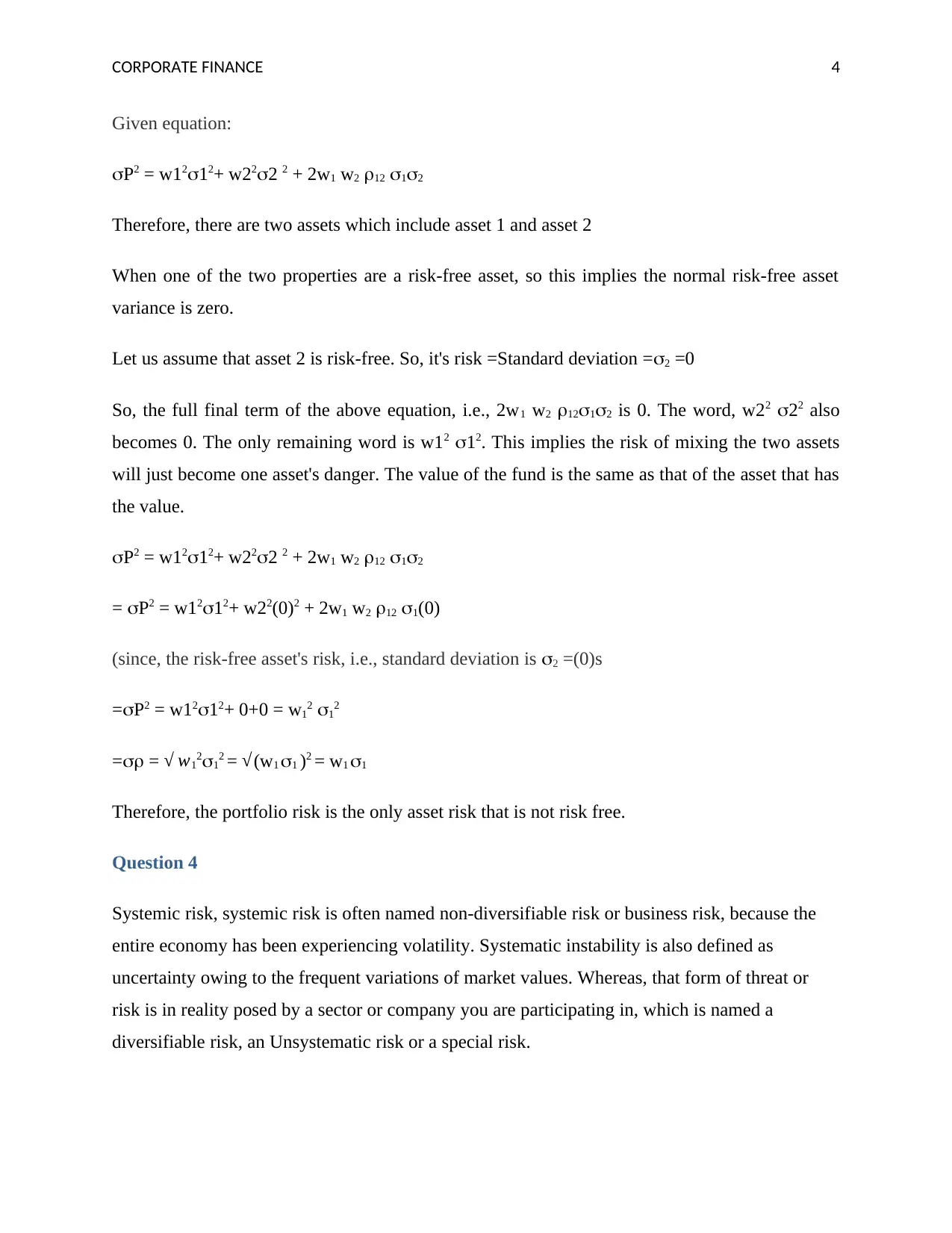
CORPORATE FINANCE 4
Given equation:
P2 = w1212+ w222 2 + 2w1 w2 12 12
Therefore, there are two assets which include asset 1 and asset 2
When one of the two properties are a risk-free asset, so this implies the normal risk-free asset
variance is zero.
Let us assume that asset 2 is risk-free. So, it's risk =Standard deviation =2 =0
So, the full final term of the above equation, i.e., 2w1 w2 1212 is 0. The word, w22 22 also
becomes 0. The only remaining word is w12 12. This implies the risk of mixing the two assets
will just become one asset's danger. The value of the fund is the same as that of the asset that has
the value.
P2 = w1212+ w222 2 + 2w1 w2 12 12
= P2 = w1212+ w22(0)2 + 2w1 w2 12 1(0)
(since, the risk-free asset's risk, i.e., standard deviation is 2 =(0)s
=P2 = w1212+ 0+0 = w12 12
= = √ w1212 = √(w1 1 )2 = w1 1
Therefore, the portfolio risk is the only asset risk that is not risk free.
Question 4
Systemic risk, systemic risk is often named non-diversifiable risk or business risk, because the
entire economy has been experiencing volatility. Systematic instability is also defined as
uncertainty owing to the frequent variations of market values. Whereas, that form of threat or
risk is in reality posed by a sector or company you are participating in, which is named a
diversifiable risk, an Unsystematic risk or a special risk.
Given equation:
P2 = w1212+ w222 2 + 2w1 w2 12 12
Therefore, there are two assets which include asset 1 and asset 2
When one of the two properties are a risk-free asset, so this implies the normal risk-free asset
variance is zero.
Let us assume that asset 2 is risk-free. So, it's risk =Standard deviation =2 =0
So, the full final term of the above equation, i.e., 2w1 w2 1212 is 0. The word, w22 22 also
becomes 0. The only remaining word is w12 12. This implies the risk of mixing the two assets
will just become one asset's danger. The value of the fund is the same as that of the asset that has
the value.
P2 = w1212+ w222 2 + 2w1 w2 12 12
= P2 = w1212+ w22(0)2 + 2w1 w2 12 1(0)
(since, the risk-free asset's risk, i.e., standard deviation is 2 =(0)s
=P2 = w1212+ 0+0 = w12 12
= = √ w1212 = √(w1 1 )2 = w1 1
Therefore, the portfolio risk is the only asset risk that is not risk free.
Question 4
Systemic risk, systemic risk is often named non-diversifiable risk or business risk, because the
entire economy has been experiencing volatility. Systematic instability is also defined as
uncertainty owing to the frequent variations of market values. Whereas, that form of threat or
risk is in reality posed by a sector or company you are participating in, which is named a
diversifiable risk, an Unsystematic risk or a special risk.
Paraphrase This Document
Need a fresh take? Get an instant paraphrase of this document with our AI Paraphraser
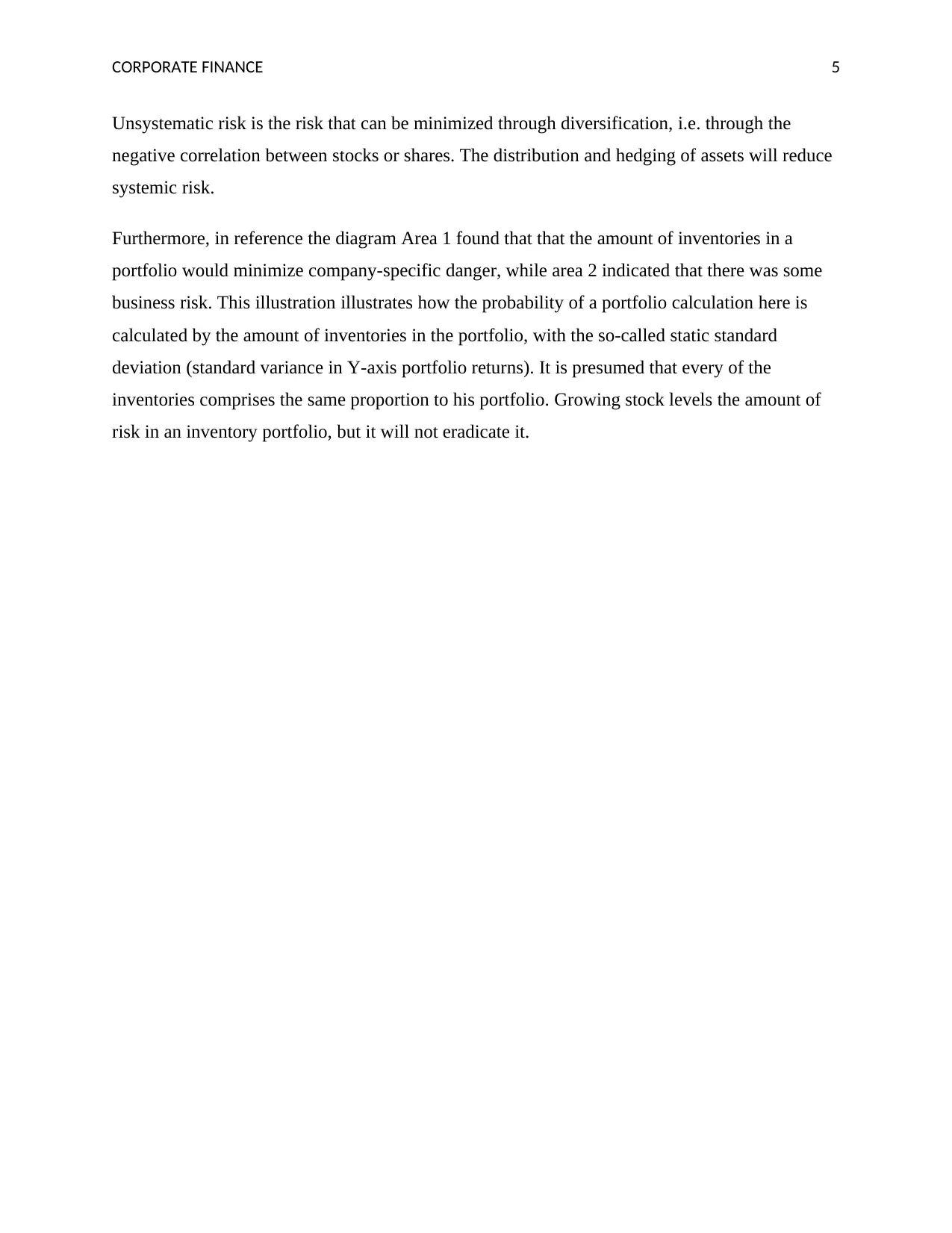
CORPORATE FINANCE 5
Unsystematic risk is the risk that can be minimized through diversification, i.e. through the
negative correlation between stocks or shares. The distribution and hedging of assets will reduce
systemic risk.
Furthermore, in reference the diagram Area 1 found that that the amount of inventories in a
portfolio would minimize company-specific danger, while area 2 indicated that there was some
business risk. This illustration illustrates how the probability of a portfolio calculation here is
calculated by the amount of inventories in the portfolio, with the so-called static standard
deviation (standard variance in Y-axis portfolio returns). It is presumed that every of the
inventories comprises the same proportion to his portfolio. Growing stock levels the amount of
risk in an inventory portfolio, but it will not eradicate it.
Unsystematic risk is the risk that can be minimized through diversification, i.e. through the
negative correlation between stocks or shares. The distribution and hedging of assets will reduce
systemic risk.
Furthermore, in reference the diagram Area 1 found that that the amount of inventories in a
portfolio would minimize company-specific danger, while area 2 indicated that there was some
business risk. This illustration illustrates how the probability of a portfolio calculation here is
calculated by the amount of inventories in the portfolio, with the so-called static standard
deviation (standard variance in Y-axis portfolio returns). It is presumed that every of the
inventories comprises the same proportion to his portfolio. Growing stock levels the amount of
risk in an inventory portfolio, but it will not eradicate it.
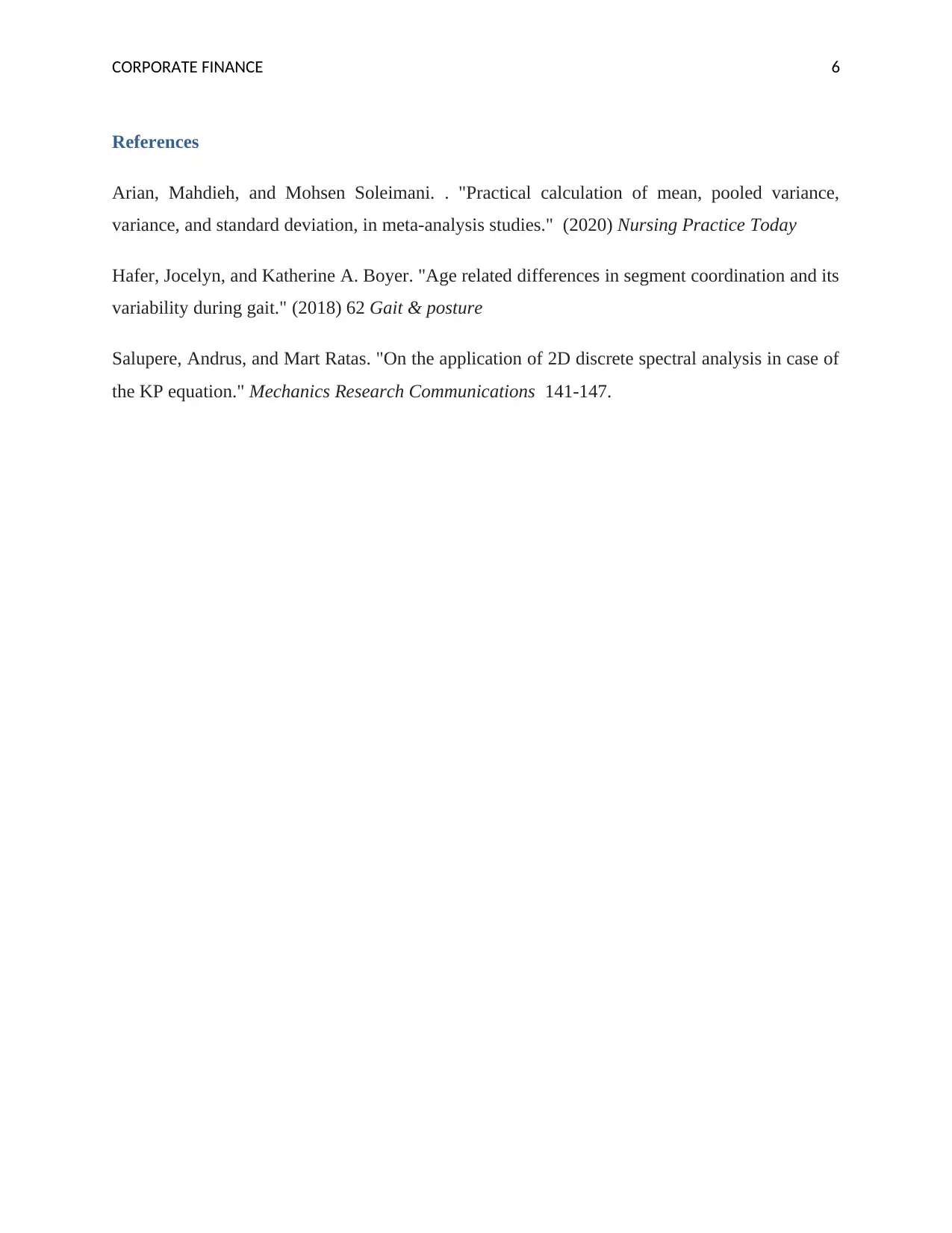
CORPORATE FINANCE 6
References
Arian, Mahdieh, and Mohsen Soleimani. . "Practical calculation of mean, pooled variance,
variance, and standard deviation, in meta-analysis studies." (2020) Nursing Practice Today
Hafer, Jocelyn, and Katherine A. Boyer. "Age related differences in segment coordination and its
variability during gait." (2018) 62 Gait & posture
Salupere, Andrus, and Mart Ratas. "On the application of 2D discrete spectral analysis in case of
the KP equation." Mechanics Research Communications 141-147.
References
Arian, Mahdieh, and Mohsen Soleimani. . "Practical calculation of mean, pooled variance,
variance, and standard deviation, in meta-analysis studies." (2020) Nursing Practice Today
Hafer, Jocelyn, and Katherine A. Boyer. "Age related differences in segment coordination and its
variability during gait." (2018) 62 Gait & posture
Salupere, Andrus, and Mart Ratas. "On the application of 2D discrete spectral analysis in case of
the KP equation." Mechanics Research Communications 141-147.
⊘ This is a preview!⊘
Do you want full access?
Subscribe today to unlock all pages.

Trusted by 1+ million students worldwide
1 out of 6
Related Documents
Your All-in-One AI-Powered Toolkit for Academic Success.
+13062052269
info@desklib.com
Available 24*7 on WhatsApp / Email
![[object Object]](/_next/static/media/star-bottom.7253800d.svg)
Unlock your academic potential
Copyright © 2020–2025 A2Z Services. All Rights Reserved. Developed and managed by ZUCOL.




